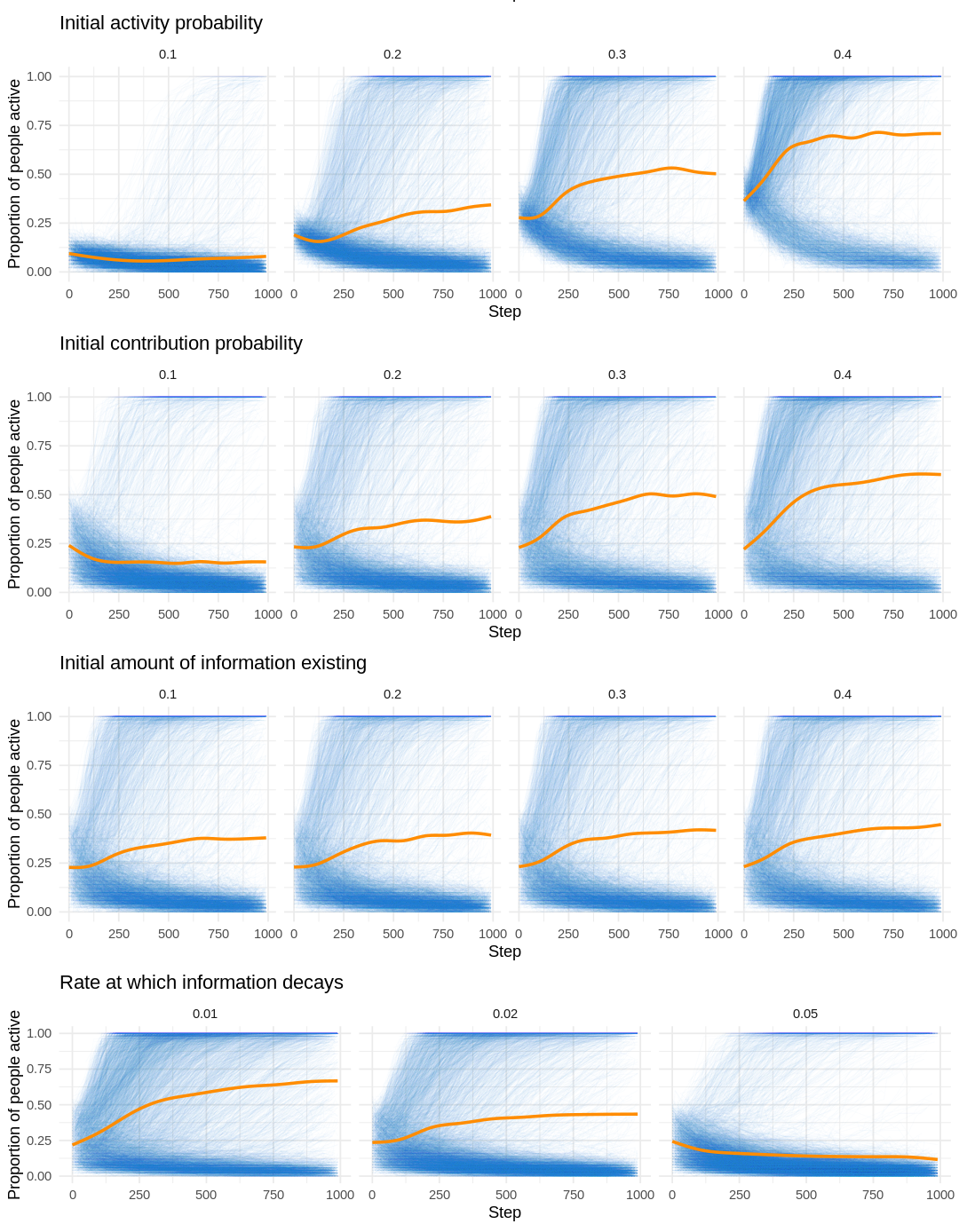Understanding the emergence of new and small online communities

Jeremy Foote
Purdue University


Intro
Group size distributions vary
Universities are log-normally distributed

Data from Wikidata
Online group sizes have long-tail distributions

Data from Stuck_in_the_Matrix on BigQuery
Why do some online communities grow?
Why do some online communities grow?
The efforts of devoted founders?


Why do some online communities grow?
Integrative early networks?
The efforts of devoted founders?

Why do some online communities grow?
Attributes of the information space?
Integrative early networks?
The efforts of devoted founders?

Why do some online communities grow?
Benefits of smallness?
Attributes of the information space?
Integrative early networks?
The efforts of devoted founders?

The role of founders
Two survey studies, on Wikia and Reddit
- There are hundreds of attempts to start new online communities every day
- Why do people start them?
- What can they do to help them grow?
Methods
- Survey of ~600 Wikia founders (2016) and ~900 Reddit founders (2023)
- Contacted directly after founding
- Asked about motivations, goals, and plans
- On Reddit, also tracked community outcomes
Foundings are cheap and easy

Founders have diverse motivations and goals

They aren’t trying to start giant communities

Founders motivations and plans predict outcomes
- Founders motivated by topical interest get more visitors, contributors, and subscribers
- Founders who planned to raise awareness get more visitors, contributors, and subscribers
Early Network Structures
Integrative workgroups are more successful
- Low hierarchy, high density, and few peripheral members
- Coordination benefits
- Transactive Memory / Shared Mental Models
- Information sharing
- Social integration
- Legitimate peripheral participation
- Group identity
Wikis should also benefit from integrative networks
- Similar to workgroups
- Group of people working together on a shared task
- Need to coordinate and make decisions
- Also
- Anonymous
- Text-based, asynchronous communication
- Little formal hierarchy
- Low barriers to exit
Methods
- ~1,000 new wiki communities
- Look at first 700 edits
- Edges between editors who edited the same page or edited a user talk page
- Measure network structure
- Density, centralization, hierarchy, and coreness
Network structures don’t matter!
- No relationship between network structure and productivity

Network structures don’t matter!
- No relationship between network structure and community survival

Why?
- Some guesses
- Specificity of topic (less need for coordination)
- Shared artifact helps to coordinate (stigmergy)
- Why is social integration not important?
Attributes of the information space
Enteprise social media are multifunctional public goods
- Public goods in economic sense - non-rivalrous and non-excludable
- Fulk et al. (1996) argue that electronic communication systems are public goods
- Connective goods
- Mostly one-to-one communication
- Communal goods
- Shared information repositories
Why do many ESMs fail?
- How do people decide whether to use them?
Interview + agent-based modeling
- 39 interviews with employees after the introduction of an ESM
- Based on findings, we developed an agent-based model
People use ESM based on whether they perceive critical mass
- Connective good
- Perceive whether others respond to posts or accept friend requests
- Communal good
- Determine whether information helps them do their work
Agent-based model
- Agents and an information space
- Each timestep, agents probaliistically
- Decide whether to be active
- Whether to try to connect with others
- Whether to try to find information
- Whether to add information
- Information probabilistically decays
Agent-based model
- If successful, they are more likely to be active and to try the given task again

The contours of the information space are important

The contours of the information space are important
- Information space can act as semi-permanent store of value
- Encourages activity which can support connective goods
- Decay rate was very important, hard to support an information community that is quickly outdated
- Perceptions of what others are doing is important
Benefits of smallness
Are small communities failures?
- Size is usually seen as a proxy for success
- But most communities start small and stay small

Interview study of small community participants
- 20 interviews with participants in small communities
- Asked about
- Experiences in the small community
- Experiences in other online communities
- Reflections on differences between the two
Small communities are different
- Highly specialized (you know what to expect)
- Places to find experts
- Less negativity (trolls ignore small communities)
- Often offshoots of larger communities
- Still few dyadic relationships
- Provide sense of control in a chaotic information environment
Toward a theory of new and small communities
How do new and small communities work?
- Founding explores the space of possible communities
- Very high competition in early days
- Path dependencies and rich-get-richer dynamics
- But also persistence of small communities
How do new and small communities work?
- Group identity is important
- Dyadic relationships don’t seem to be
- Low costs of entry and exit
- Lots of interdependence between communities (TeBlunthuis et al., 2023)
Implications for organizational research
- Shared artifacts can do lots of coordination work
- Puzzle of why social integration isn’t important
- Online communities may identify people who are already eager to participate
- Maybe early-stage members are the devoted early adopters
- Need to develop new tools to understand interdependence
Implications for organizational research
- Online communities are a rich context
- Data about many organizations
- Data about individuals moving between organizations
- Rich text data
Implications for platform design
- New metrics for success and community health
- More support for diverse types of communities
Important open questions
- What causes the skewed distributions of participation?
- How does additional structure emerge as communities grow?
- What is AI going to do to small communities?
Thanks!
Collaborators for this work:








Extra slides
Reddit founders regression


Early networks scatterplot
